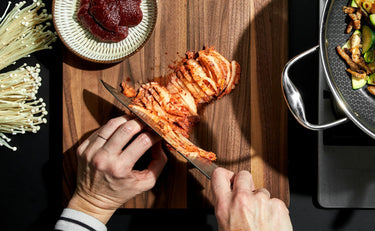January Cooking Challenge: Make A Ferment

January 2025 is your month to face new cooking challenges, master novel skills and have fun. First up were vegetables. Now, let's talk the effervescent art of fermentation.
Fermentation might seem intimidating, but chances are you’re already enjoying fermented foods regularly. Sandor Katz, author of The Art of Fermentation and Wild Fermentation, reminds us that staples like vinegar, soy sauce, chocolate, coffee, miso and even vanilla are all fermented.
“Fermentation represents an incredible range of everyday staples and luxurious treats,” Katz says. So why not try making your own in 2025? Katz encourages everyone to dive in, not just for the probiotics but for the extraordinary flavors and the joy of crafting fresh, nutritious foods to share.
You Probably Already Have What You Need
There are no special tools required to begin fermenting, said Katz. A sharp knife, wooden cutting board, mixing bowls and large, clean jars are a great place to start.
Kirsten Shockey, a fermentation expert and author of Homebrewed Vinegar and Fermented Vegetables, agrees. “Lots of people will tell you that you need a weight or an airlock, but you don’t. A jar with a lid is perfect.”
Both Katz and Shockey emphasized the low barrier to entry with fermentation. Though you can buy gorgeous, expensive fermentation crocks, they aren’t necessary. That said, Shockey said that anyone who is intimidated by fermentation should buy what makes them feel confident: “If that lid makes you feel you can do this, buy the lid.”

Time and Temperature are Crucial
Fermentation doesn’t follow a strict timeline; the process speeds up in warmer temperatures as microbes become more active. Katz explained, “Fluctuation in temperature is not inherently bad, but the higher the temperature, the higher the organisms go, so the faster your sauerkraut will go sour, but the faster the enzymes that can decompose food will go, too.”
For the best results, ferment in a cool—not hot—kitchen. Daily tasting helps you track the level of sourness and texture to suit your preference. If your kitchen is particularly hot, Katz recommends using more salt or moving your ferment to the fridge, where it will continue to ferment more slowly. Temperature fluctuations aren’t a dealbreaker, but keeping an eye on your ferment ensures it develops just right.
What’s the Best Salt?
No need for special salts. Katz advises using what you have and avoiding over-complicated details about iodine or mineral content. For beginners, start with less salt and adjust to taste—adding is easier than removing. Taste your mixture before packing it into jars to ensure the salinity is just right.

Begin With a Simple Vegetable Ferment
Vegetables are the easiest gateway into fermentation. Shockey compares it to “making a salad and squishing it into a jar.” Katz suggests this no-recipe method:
- Shred veggies: Cut as finely or coarsely as you like.
- Add salt: Toss with salt in a mixing bowl, massaging to coat. Let the mixture sit for a few hours, allowing the salt time to draw water out of the vegetables (by osmosis). Our HexMill grinders are the perfect tool for this step.
- Check the juice level: After a few hours, squeeze a handful of the mixture. If water drips like a sponge, they’re ready. Massage more if needed.
- Pack the jar: Transfer veggies and juice into a clean jar (that has a lid), pressing firmly to submerge them in liquid.
- Weigh it down: Oxygen is the enemy of a good ferment, so you need something to hold the veg beneath the liquid. Katz likes using a cabbage leaf with a heavy spine if he’s making sauerkraut, but half an onion or an apple works, too. Seal with a lid.
- Wait and taste: Let the jar sit for 3 to 4 days to start, then taste daily. Press veggies back under the liquid after sampling. If you’d rather let the ferment sit for a dedicated number of days but are worried about it bubbling over, simply “burp” the jar, says Shockey. To do this, release the lid just enough to hear the gasses release—it should make a pffft sound—and then replace the lid tightly.
- Refrigerate finished ferment: Once the ferment is at the level of texture and taste you like, transfer it to your “fermentation-slowing device,” aka, your refrigerator. There, it can be stored indefinitely.
Conquer Your Fermenting Fears
Worried about safety? Katz and Shockey emphasize that properly submerged ferments are safe. Mold, which needs oxygen, won’t grow if the food stays beneath the liquid. “It’s hard to get it wrong,” Shockey assured. If something smells or looks off, you’ll know not to eat it. (Unlike canning, fermentation doesn’t hide unseen dangers.)
There are countless reasons to start fermenting, from enjoying unique flavors to embracing culinary creativity. Katz and Shockey also highlight its deeper impact: building a connection with local food systems.
“Part of why I do what I do is the hope that maybe starting out with a little jar of pickles or sauerkraut ends up taking you to that next place of wanting to explore more what it means to connect with your food, your local farmer, and with this planet as a whole,” said Shockey.
She added, “Sometimes I say my goal is a jar of something bubbling on everybody’s counter. For people who live in a flat in a giant city, they might not have a lot of space for that connection. Deciding to eat whole foods and cook whole foods is an act of resistance.”
So get bubbling.





